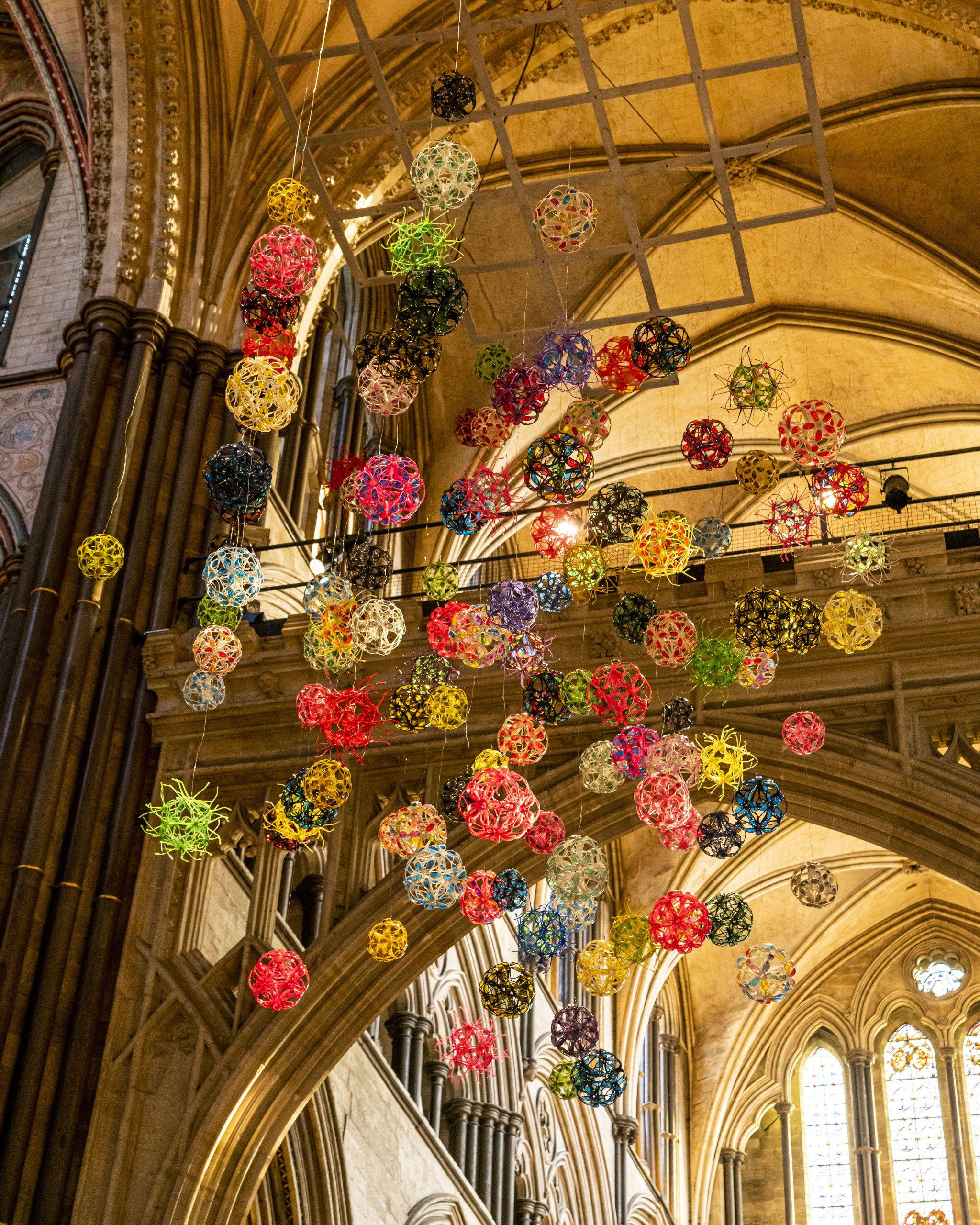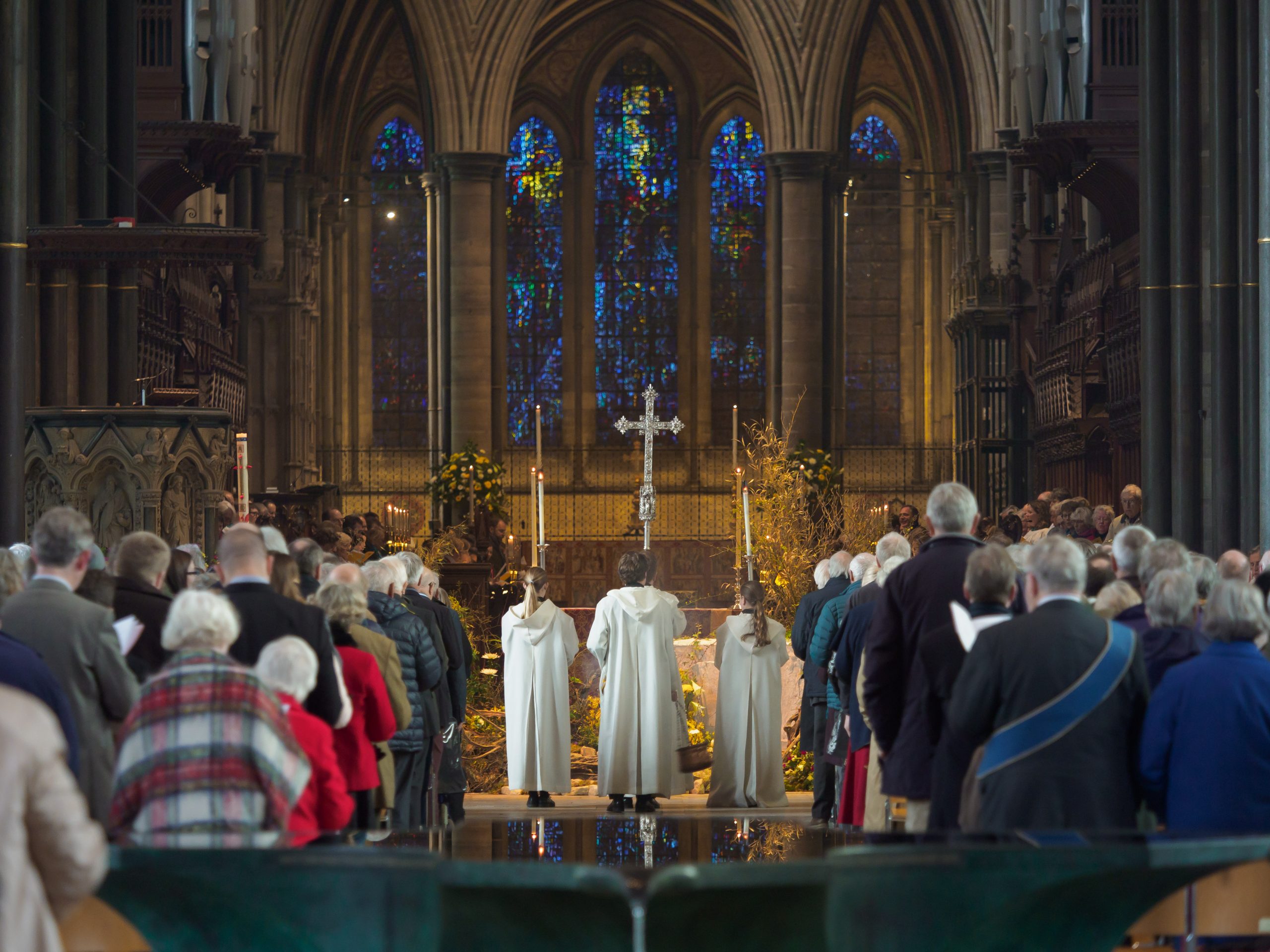Reflections on David Batchelor’s Christmas installation

A Sermon on colour: human limits and God’s perfection preached by Canon Kenneth Padley, Treasurer.
Sunday 15 January 2023, The Second Sunday of Epiphany.
Ezekiel 2.1-3.4; Galatians 1.11-24
One of the most fascinating conversations I have since coming to Salisbury took place in the south choir aisle, early one morning in September. I was approached by a smartly dressed man of about 30. He was from India and told me that his employer had sent him to Wiltshire on a business trip. He had attended morning prayer to intercede for his wife and young family so far away. However, his particular desire to pray in Salisbury Cathedral was a peculiar mix of personal and professional pilgrimage.
The man told me that he was employed by Tintometer Limited. Their facilities and staff are scattered across the globe (evidently including in India) but the company is based in Amesbury. Tintometer was founded in the late nineteenth-century by Joseph Williams Lovibond. Lovibond was a brewer, who in pursuit of the perfect pint, was keen to establish a quantitative scale for measuring the colour of beer. Early experiments had failed and Lovibond was disheartened. However, he was blessed in 1880 with a revelatory insight while attending an act of worship… in Salisbury Cathedral. Gazing at the tints and hues around him, Lovibond became inspired to use different shades of stained glass to measure the colour of his amber brew. Five years later, he launched a colorimeter, the world’s first objective measurement of colour. The Lovibond Colour Scale would follow and the science of the measurement of colour was born.
Given this seminal if unintended role played by Salisbury Cathedral in the process of defining colour, I can think of no better venue to explore the reality, meaning and value of colour. We have been honoured to do so through the work of David Batchelor, especially during these seasons of Advent and Christmas, from late November to early February, when the Church moves from darkness to light.
With these intersections in mind, I see in David’s stunning Disco Mechanique a reflection of the universe, the rolling spheres which God in Her inscrutable wisdom willed to birth – and then chose to inhabit in the tiny particularity of a baby in ancient Palestine. We have the enormity of God’s timeless plan, motifs particularly associated with Advent, merging into the colourful decorations with which we celebrate Christmas.
Over hundreds of years, people of faith have considered and celebrated the diversity and beauty of God’s creation through their use of colour. But of course, initially, they had no language, no words, for that with which they were grappling. Colour, literally, left them speechless. I am deeply indebted to my colleague on the Cathedral’s Arts Advisory Panel, Revd Stephen Tucker, for drawing my attention to the arresting observation that when our forebears started to write the Bible, while they had terms for the intensity of light – from dazzling to deep darkness, they had very few specific colour-terms. This is especially true in the Hebrew Scriptures, the Christian Old Testament, where only the colours of white, red and green are distinguished by name. For the most part, the Old Testament, in common with other ancient literature, could only imply a sense of colour through comparison with other objects, both natural and manufactured.
Let me offer an example. Tonight’s scripture texts reflect the themes of this Sunday. We are near the start of Jesus’ ministry and so are giving thanks for his calling of disciples, both then and now. That summons of the prophet which we heard from Ezekiel chapter 2 is prefixed by a vivid overture in chapter 1 in which Ezekiel has a dramatic encounter with the almighty. It is an explosive vision of dynamic humanoid figures with wings and faces and wheels, all whirring around under God’s throne. The writer does not have words for colour to aid his description – and so he turns to similes instead. Across more than 20 verses we read about a fire ‘like gleaming amber’, legs ‘like burnished bronze’, wheels ‘like gleaming beryl’, a dome ‘like shining crystal’, a throne ‘like sapphire’. Finally, in verse 28, Ezekiel moves beyond the whacky humanoid figures to the Almighty. To what might he liken God himself? Ezekiel finds himself at the limits of his vocabulary as much as of his imagination as he launches out beyond monochrome similes into the visually most fulsome illustration that he knew. God’s glory, says Ezekiel is like, is like ‘the bow in the cloud on a rainy day’. We in the twenty-first century know how the rainbow refracts a beam of light so as to reveal its constituent colours. Ezekiel lacked such scientific understanding, but he saw in the rainbow the greatest image available to him for the truth that he knew deep inside: that God alone is, and owns, the full spectrum.
Mindful of the experience of Ezekiel and others, I wonder to what extent God’s revelation of the magnitude and variety of God’s self has catalysed the human desire to name and celebrate diversity? With the exception of a few iconoclastic and puritanical phases, the Church has used much colour to articulate the invisible truths of the gospel. Think of the glories of Anglo-Saxon illuminated manuscripts, medieval vestments, and renaissance frescoes. Enter the industrial era and Anglo-Catholic missions flourished in drab cities by sharing a foretaste of heaven through colourful wood, stone, glass, metal and cloth.
Given this role of colour in articulating celestial realities, I wonder if it is more than coincidence that the very first Christian convert in Europe was a seller of colour? We read in Acts chapter 16 of a woman called Lydia who was trading purple cloth in northern Greece when she was converted through the preaching of St Paul. Lydia found in Jesus something even more precious, more vibrant, than the rich fabric she was purveying.
I suggest our twenty-first century understanding of colour has reached a point of paradox. The objectification of colour which owes so much to that chance insight of Joseph Williams Lovibond in this holy place has burgeoned in the 143 years since into an almost endless palette of RAL numbers, swatch cards and digital editing. But this open-ended cornucopia of possibility only serves to expose our limited appreciation of colour, our preferences and indeed our prejudices. The expression and measurement of contemporary colour is objective, but our appreciation of it can only ever be subjective. We know what we like and we find it comforting. We know what we dislike and which we shun because it is more challenging.
Therefore, maybe we are chromophobic because we are inherently sinful: limited and flawed and so biased and discriminatory. We need artists like Ezekiel, and prophets like David Batchelor, to remind us of the fuller picture, to call us back to the polychromatic panoply of God.




